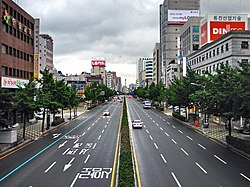
Busan, officially Busan Metropolitan City, is South Korea's second most populous city after Seoul, with a population of over 3.3 million inhabitants as of 2024. Formerly romanized as Pusan, it is the economic, cultural and educational center of southeastern South Korea, with its port being South Korea's busiest and the sixth-busiest in the world. The surrounding "Southeastern Maritime Industrial Region" is South Korea's largest industrial area. The large volumes of port traffic and urban population in excess of 1 million make Busan a Large-Port metropolis using the Southampton System of Port-City classification. As of 2019, Busan Port is the primary port in Korea and the world's sixth-largest container port.

South Korea is made up of 22 first-tier administrative divisions: 6 metropolitan cities, 1 special city, 1 special self-governing city, and 14 provinces, including three special self-governing provinces and five claimed by the ROK government. These are further subdivided into a variety of smaller entities, including cities, counties, districts, towns, townships, neighborhoods and villages.

Haeundae District is a district (gu) of Busan, South Korea.

Dongnae District is a gu in central Busan, South Korea.

Dong District is a gu (district) in northeastern part of Daegu metropolitan city of South Korea. Daegu city itself lies in the southeastern part of Korean Peninsula. It has a population of 343,678. The district covers 182.35 km², for about 20% of Daegu's total area.

Nam is a gu, or district, in south-central Busan, South Korea. Much of Nam-gu sticks out into the Sea of Japan, forming a peninsula which separates Suyeong Bay from Busan Harbor. It has an area of 25.91 km2. Nam-gu officially became a gu of Busan in 1975. In 1995 part of Nam-gu was divided to form Suyeong-gu.

Geumjeong District is a district in north central Busan, South Korea. Approximately 7.3% of Busan's population is in Geumjeong-gu. The Hoedong Reservoir is located on the district's eastern boundary, and the mountain Geumjeongsan on the west. Because of this, 75% of the district's land is restricted from residential development. The district's population is concentrated in the valley of the Oncheoncheon stream, a tributary of the Suyeonggang.

Suyeong District (Korean: 수영구) is a district (gu) in central Busan, South Korea. It has a population density of about 17,768 inhabitants per square kilometer (46,020/sq mi).
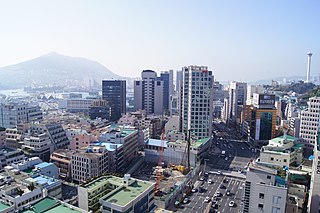
Jung District is a gu in southern central Busan, South Korea. It has an area of 2.8 km², and a population of about 48,000.
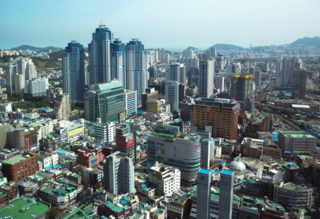
Busanjin District is a gu in central Busan, South Korea. It has an area of 29.7 km2, and a population of about 410,000. The name is sometimes abbreviated locally as "Jin-gu". Busanjin-gu is home to a major shopping, entertainment, and business area called Seomyeon.

Saha District is a gu in western Busan, South Korea. It has an area of 40.89 km², and a population of about 375,000. About a third of the area is forest land. Saha-gu became a gu of Busan in 1983. It is home to the Seunghak Campus of Dong-A University.

Yeonje District is a gu in central Busan, South Korea. It has an area of 12.08 km2, and a population of about 220,000. Yeonje-gu was created in March 1995 following its separation from Dongnae-gu. Its name was formed by taking the first and last syllables of the names of its only 2 legal dong; Yeonsan-Dong and Geoje-Dong. Busan City Hall is located in Yeonje-gu.
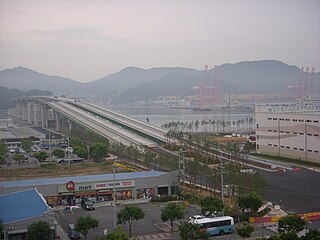
Gangseo District is a gu on the west side of Nakdong River in Busan, South Korea. It has an area of 179.05 km2, and a population of about 66,000; it has a lower population density than Gijang county of Busan. Gangseo-gu was part of Buk-gu from its creation in 1978 to 1989 when it became an independent gu.

Sasang District is a gu in central Busan, South Korea. It has an area of 35.84 km2, and a population of about 275,000. Sasang-gu became a gu of Busan in 1995.
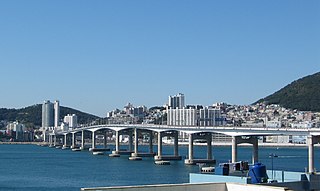
Seo District is a gu, or district, in south-west central Busan, South Korea.

Yeongdo District (Korean: 영도구) is a gu (district) in Busan, South Korea. The gu itself is limited to Yeong-do located on the south edge of central Busan. It attained the status of gu in 1957.
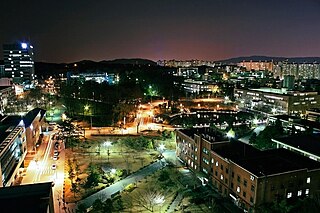
Nowon District (Nowon-gu) is a residential district of Seoul, South Korea, located in the most northeastern part of the metropolitan city. It has the highest population density in Seoul, with 619,509 people living in the area of 35.44 km².

Nam District (Nam-gu) is a district of Ulsan, South Korea. Its name literally means "South Ward".
Seomyeon Medical Street (Korean: 서면메디컬스트리트) refers to a medical district in Busanjin-gu, Busan named after and centered on the thoroughfare within a 1 kilometre (0.62 mi) radius of the Seomyeon Lotte Department Store and Buam Station. It is one of three medical districts being devised by the Government of Busan and is the most concentrated in all of South Korea.

Geumseong is a dong, or precinct, in Geumjeong-gu, Busan, South Korea. A lightly populated district, it is situated entirely within the mountain range of Geumjeongsan. It is bounded to the west by Hwamyeong-dong and Geumgok-dong in Buk District, to the northwest by Dong-myeon of Yangsan City, to the east by Cheongnyong-dong, Namsan-dong, Guseo-dong, and Jangjeon-dong of Geumjeong-gu, and to the south by Oncheon-dong in Dongnae-gu. The northernmost point in Geumseong-dong is at Godang-bong, the highest peak in Geumjeongsan.
